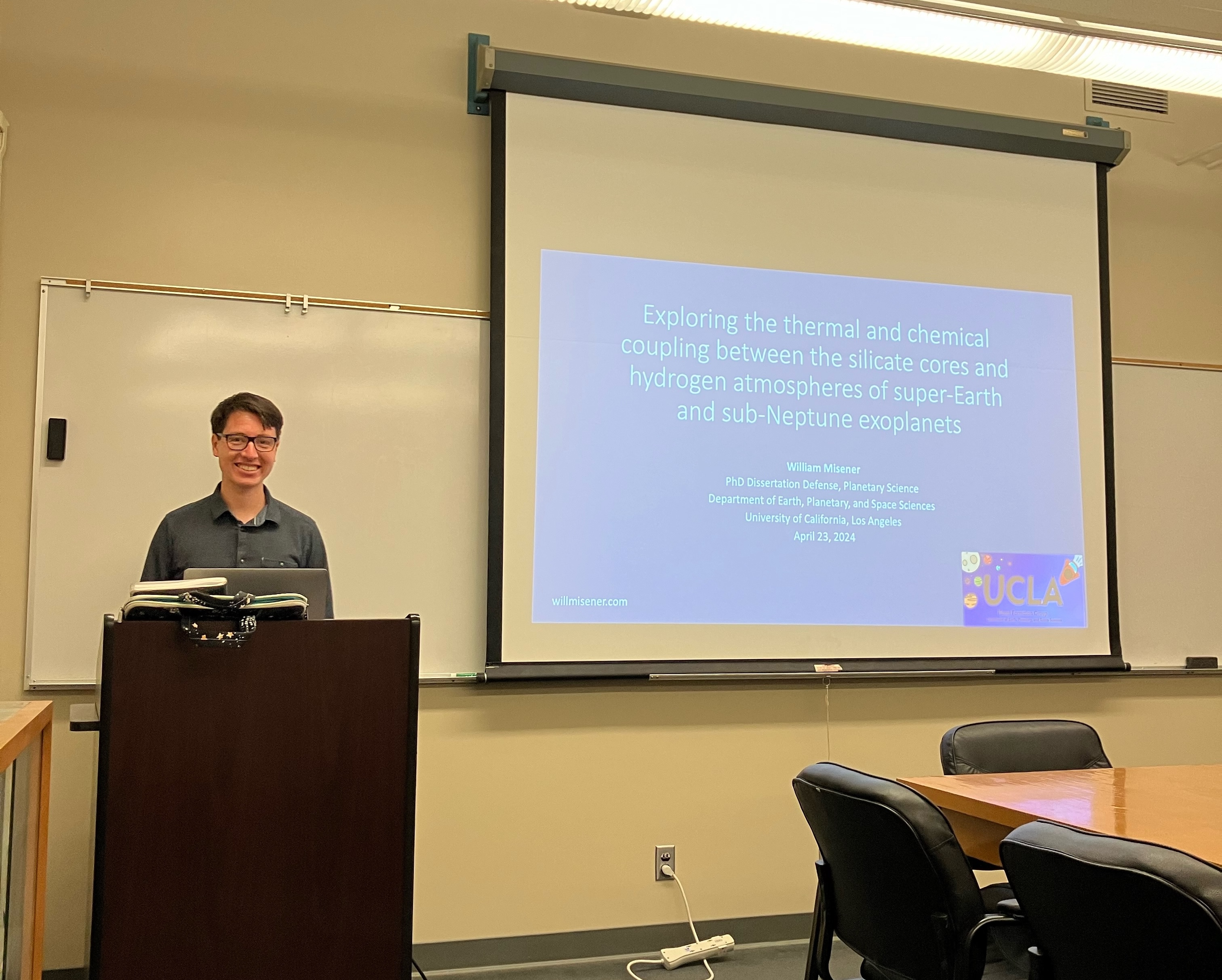My Research
I seek to understand how planets form and evolve, from their beginnings in the protoplanetary disk to their long-term atmospheric compositions. I am particularly interested in how traditionally separate aspects of planetary science, like interior evolution, atmospheric chemistry, mass loss, and disk processes, interact and influence each other. These days I mostly focus on super-Earths and sub-Neptunes. These planets, with sizes in between Earth and Neptune, are the most common type of exoplanet yet discovered, but their formation, interiors, and surface conditions remain mysterious. Read on for a summary of the work I've done in the field, or jump directly to my work on silicate vapor in sub-Neptunes, residual hydrogen gas in super-Earths, or the work I conducted pre-graduate school.



Silicate Vapor in Sub-Neptunes

In Misener & Schlichting (2022), I show that silicate vapor, expected to be present in abundance at the base of young, H-rich sub-Neptune atmospheres, can inhibit convection. This inhibition is due to the mean molecular weight gradient formed by the condensable SiO vapor, which increases in abundance with increasing temperature. The resultant near-surface radiative layer can have a steep temperature gradient. This steep interior gradient decreases the width of the atmosphere, making it appear smaller than a fully convective atmosphere of the same atmospheric mass. Our work implies that the atmospheric mass fractions of sub-Neptunes inferred from fully convective models may be too low by a factor of five. Younger planets with more massive atmospheres have the largest differences. Differences are also larger in more massive planets with higher equilibrium temperatures. Effects from this inhibition of convection can persist on gigayear timescales. As the inhibition of convection due to heavy condensables has been known in solar system literature for decades, this work demonstrates the synergy between solar system and exoplanet interior theory. It also shows how the interaction between the interiors and atmospheres of small planets can be important in myriad ways to these planets' overall evolution.
I followed this work up with Misener, Schlichting, & Young (2023), which examined the chemical equilibrium expected in these atmospheres. We find that silicate species react with the background hydrogen to produce silane (SiH4) and water. The abundances of these chemical products of magma-atmosphere interactions decline with altitude, inhibiting convection over an even wider range of temperatures than we found in our 2022 work. This work shows that water is a natural product of magma-atmosphere interactions in sub-Neptunes. It also indicates that silane could be an observable product of sub-Neptune interiors.
Residual Hydrogen Atmospheres in Super-Earths
In Misener & Schlichting (2021), I led work investigating the atmospheric evolution of super-Earths. Super-Earths and sub-Neptunes are hypothesized to have formed as one population. But small planets are expected to undergo significant atmospheric stripping early in their evolution, due either to UV light emitted by their young host stars (a process termed "photo-evaporation") or due to the release of heat from their cooling interiors ("core-powered mass loss"). I showed that at the end of core-powered mass loss, super-Earth cores are able to cool faster than their atmospheres lose mass. This cooling allows the atmospheres to contract and preserve any remaining primordial gas. These findings imply that super-Earths that form via atmospheric stripping may retain hydrogen gas, which could affect the long-term surface chemistry and habitability of this common class of exoplanet. I derived analytic scalings which show the diverse final atmospheric states super-Earths can have, with atmospheric masses ranging from negligible amounts to >10-4 times the mass of the planet, equivalent to hundreds of bars of leftover hydrogen gas. These analytic estimates are complemented by numerical integrations of these planets' mass loss and cooling, which agree with the scalings. This work shows that the atmospheres of super-Earths may be more detectable than previously thought, provided other processes do not consume the primordial hydrogen in the mean time. Such detections could be used to constrain the initial hydrogen masses accreted by the planets from the protoplanetary disk.
Bonus: read a science-fiction short story based on these hydrogen atmospheres written by Daniel Bensen, beginning on p. 18 here. This partnership was organized by the Exoplanet Demographics conference in 2020.


Work Previous to Graduate School


Dust Grain Growth and Transport in Protoplanetary Disks
In Misener, Krijt & Ciesla (2019), I constructed a novel model for tracking the coupled growth and transport of individual small dust grains in protoplanetary disks. This model allows study of the diverse environments an individual grain encounters in the early stages of planet formation, while reproducing overall population trends. The collisional properties of dust, which dictate how it grows or erodes in time, and the movement of material through the disk are deeply linked, so it's important to model the two processes together. We found that diffusion alone is ineffective at transporting solid material outward, as the particles grow too fast. This growth leads to inward drift due to increasing drag from the gas. Mixing of material of different origins into the same body is much more effective if growth is limited by fragmentation rather than bouncing. This publication resulted from working with Professor Fred Ciesla and Dr. Sebastiaan Krijt at the University of Chicago as a Research Assistant for my junior and senior years of undergrad. This was also the topic of my honors Physics thesis.
Crater Counts on Mars
While an undergrad, I also participated in crater counting in the lab of Professor Edwin Kite. Crater counts are one of the only remote methods of dating the surfaces of other planets, but the counts themselves are time-consuming and usually requires significant expertise. My counts were part of an effort to produce expert-level crater counts by aggregating the efforts of a number of undergraduate researchers, whose time is relatively cheap. The results were published in Kite & Mayer (2017).
